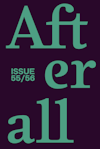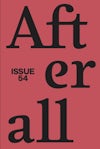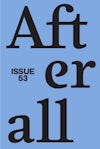
Issue 34
Autumn/Winter 2013
Issue 34 considers the inscription of ideology, power and desire in cultural production through the work of Lene Berg, Mary Ellen Carroll, Lili Dujourie, Lucy McKenzie and Haegue Yang. We also look at Mike Kelley’s ‘The Uncanny’, social realist painting in the Philippines and the turn to participation.
Editors: Melissa Gronlund, Anders Kreuger, Pablo Lafuente, Stephanie Smith, Nuria Enguita Mayo, Helena Vilalta, Louise O’Hare.
Founding editors: Charles Esche, Mark Lewis.
Table of contents
Foreword
Contextual Essays
- Taking Part in the Museum – Sabine Breitwieser
- Social Realism: The Turns of a Term in the Philippines – Patrick D. Flores
Artists
Lucy McKenzie
- Lucy McKenzie: Manners – Isla Leaver-Yap
- From the Highlands to Clydebank: ‘The Inventors of Tradition’ – Victoria Kelley
- Rodchenko’s Worker’s Suit Had No Fly
Mary Ellen Carroll
- This Is Not About a Building: Mary Ellen Carroll’s prototype 180 – Gavin Kroeber
- From Busan with Humour – Ruth Noack
Haegue Yang
- Haegue Yang: Untimely Histories
Lili Dujourie
- The Actions of Bodies: Approaching Lili Dujourie – Anders Kreuger
- Lili Dujourie: Desire and Withdrawal – Sinziana Ravini
Events, Works, Exhibitions
- Something I’ve Wanted to Do But Nobody Would Let Me: Mike Kelley’s ‘The Uncanny’ – Valerie Smith
- Bodyimage: Lene Berg’s Kopfkino – Ian White
Foreword
Written by Nuria Enguita Mayo
Minimal art’s unquestionable and secure place within the Western art canon is perhaps surprising if we consider how it contributed to the departure from the museum as the specific realm for art, and gave momentum to new hybrid and experimental art practices in dialogue with disciplines such as dance. Published in 1965 with the intention of thoroughly debunking the idea of expressionism in form, Yvonne Rainer’s ‘No Manifesto’ has often been associated with ‘minimalist negation’. However, it is possible to return to it via different routes, and to read it through the irruption of feminist politics and discourses in the art of that time, and its ramifications in subsequent decades.
No to spectacle.
No to virtuosity.
No to transformations and magic and make-believe.
No to the glamour and transcendence of the star image.
No to the heroic.
No to the anti-heroic.
No to trash imagery.
No to involvement of performer or spectator.
No to style.
No to camp.
No to seduction of spectator by the wiles of the performer.
No to eccentricity.
No to moving or being moved.
In light of concurrent analyses of female identity as a social and cultural construct, the manifesto becomes a categorical ‘no’ to the patriarchal power that gave shape to mechanisms of vision (in film, painting, sculpture or architecture) based on male control over the bodies, discourses and destinies of the female — ranging from the representation of women’s bodies as sexualised objects in the history of Western art and film to the control over their daily lives at work, school or home. The manifesto also appears to reject the idea of the male creative genius, in contrast to the more collaborative and less authorial female work. From the 1960s onwards, art became a privileged territory for the development of new subjectivities and an experimental space from which to face new identification processes. This was favoured by the dematerialisation and expansion of art practices, and the steadfast advent of time-based art forms in particular, as well as by feminist discourses based on psychoanalysis and structuralism and the introduction of postcolonial movements and discourses. Their legacy, as Patrick D. Flores argues in these pages, invokes a ‘revolutionary continuum sparked by a long history of colonial struggles’, which can be traced as far back as nineteenth-century history painting.
The art practices brought together in this issue of Afterall take part in these openings and show their complex evolution, whilst also proposing a retreat of art to the borders that separate it from other disciplines. At a moment of dystopia and crisis that is both reminiscent of and different from that of the 60s, they propose practices of resistance articulated through painting, sculpture, film, architecture, exhibition-making and fashion design. Faced with the impossibility of understanding the world in its totality, these practitioners approach the real, personal and collective identity and communal spaces in ways that are not based on essentialist categories. Today, they seem to claim, art can still be an experimental terrain, prone to transgression and efficient critiques of the norm.
In the work of Lili Dujourie and Lucy McKenzie, this practice of resistance concentrates heavily on the uses (and abuses) of art materials conceived not only as matter carrying specific attributes or qualities, but also as media loaded with meaning. Spanning almost half a century, Dujourie’s practice is as oblivious to trends as it is attentive to the present moment, and often articulates subtle critiques of dominant art models. In her series of videos Hommage à… I–V (1972), for example, the artist subtly explores and subverts the construction of the female image in the work of artists such as Titian, Manet, Ingres or Courbet. Standing simultaneously as artist, model and spectator, here her body is only subject to her own gaze. These videos anticipate the constant tension between form and content, the depiction of the body and its absence, that characterises her subsequent sculptures in velvet, lead, marble, plaster, iron wire or papier mâché.
Purchase
The publication is available for purchase. If you would like specific articles only, it is also available individually and to be downloaded as PDFs.
Purchase full publication
Buy via University of Chicago Press
Buy via Central Books
Purchase individual articles
Buy via University of Chicago Press



